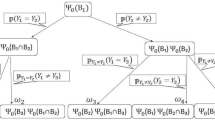Abstract
The stick-breaking representation is one of the fundamental properties of the Dirichlet process. It represents the random probability measure as a discrete random sum whose weights and atoms are formed by independent and identically distributed sequences of beta variates and draws from the normalized base measure of the Dirichlet process parameter. It is used extensively in posterior simulation for statistical models with Dirichlet processes. The original proof of Sethuraman (Stat Sin 4:639–650, 1994) relies on an indirect distributional equation and does not encourage an intuitive understanding of the property. In this paper, we give a new proof of the stick-breaking representation of the Dirichlet process that provides an intuitive understanding of the theorem. The proof is based on the posterior distribution and self-similarity properties of the Dirichlet process.
Similar content being viewed by others
References
Blei, D. M., & Jordan, M. I. (2006). Variational inference for Dirichlet process mixtures. Bayesian Analysis, 1(1), 121–143.
Broderick, T., Jordan, M. I., & Pitman, J. (2013). Cluster and feature modeling from combinatorial stochastic processes. Statistical Science, 28(3), 289–312.
Chung, Y., & Dunson, D. B. (2011). The local Dirichlet process. Annals of the Institute of Statistical Mathematics, 63(1), 59–80.
Ferguson, T. S. (1973). A Bayesian analysis of some nonparametric problems. The Annals of Statistics, 1(2), 209–230.
Ghosh, J., & Ramamoorthi, R. (2003). Bayesian nonparametrics. New York: Springer.
Ishwaran, H., & James, L. F. (2001). Gibbs sampling methods for stick-breaking priors. Journal of the American Statistical Association, 96(453), 161–173.
MacEachern, S. N. (2000). Dependent Dirichlet processes. Unpublished manuscript, Department of Statistics, The Ohio State University, pp 1–40.
Miller, J. W. (2018). An elementary derivation of the Chinese restaurant process from Sethuraman’s stick-breaking process. arXiv preprint arXiv:1801.00513.
Neal, R. M. (2000). Markov chain sampling methods for Dirichlet process mixture models. Journal of Computational and Graphical Statistics, 9(2), 249–265.
Rodriguez, A., Dunson, D. B., & Gelfand, A. E. (2008). The nested Dirichlet process. Journal of the American Statistical Association, 103(483), 1131–1154.
Sethuraman, J. (1994). A constructive definition of Dirichlet priors. Statistica Sinica, 4, 639–650.
Acknowledgements
Jaeyong Lee was supported by the National Research Foundation of Korea (NRF) Grant funded by the Korea government(MSIT) (no. 2018R1A2A3074973), and MacEachern was supported in part by the National Science Foundation of the United States.
Author information
Authors and Affiliations
Corresponding author
Additional information
Publisher's Note
Springer Nature remains neutral with regard to jurisdictional claims in published maps and institutional affiliations.
Rights and permissions
About this article
Cite this article
Lee, J., MacEachern, S.N. A new proof of the stick-breaking representation of Dirichlet processes. J. Korean Stat. Soc. 49, 389–394 (2020). https://doi.org/10.1007/s42952-019-00008-w
Received:
Accepted:
Published:
Issue Date:
DOI: https://doi.org/10.1007/s42952-019-00008-w



